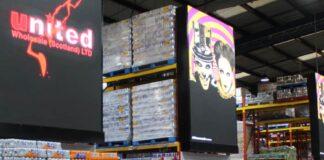4. Good signage: Make customers look up from their shopping lists.
“The average time a shopper spends in a convenience store is just five minutes. During this time, 52% miss signs and messages while only one in six shoppers visits all the aisles. So messaging is critical to attracting customers to your promotion,” says field marketing specialist eXPD8’s Amanda Heritage.
Matt Gouldsmith, head of route to market at Lucozade Ribena Suntory, agrees that displays and point-of-sale (PoS) material are critical in increasing visibility and impulse purchases.
“Two-thirds of retailers make a shopping list, which makes it difficult for wholesalers to increase spend per trip. It is therefore critical to focus on the visibility of promotional signage and location in-depot.”
While third-party support can help to keep track of promotions at retail level, there is no substitute for face-to-face meetings with suppliers at wholesale level. Dhamecha invests heavily in its promotions and expects suppliers to do the same.
“Promotions are an important part of helping our customers to compete,” says Dhamecha’s Naren Chotai. “We’d like to see more investment from suppliers – those who make the effort to visit our branches and build relationships with depot managers really reap the rewards.”











GETTING A GOOD DEAL OUT OF GOOD DEALS: THE ART OF PROMOTION MANAGEMENT
The impact of price promotions on sales has become ever more important to the extent that they often play a dominant role in profit generation and really drive consumer behaviour – which is exactly what they are designed to do, of course. However, the way promotions pump up sales volumes and have an impact on the sales of other lines puts great stress on the supply chain, especially on the forecasting and replenishment of fresh goods.
The challenge lies in incorporating promotion forecasting and replenishment into the supply chain planning processes; this can typically be overcome by following seven best practice tips.
1. Manage campaign information and forecast variables in the forecasting system;
2. Include logistical information such as required presentation levels as well as preferred delivery dates for initial quantities including stock for presentation purposes;
3. Let the system calculate the promotion forecast for consumer sales as well as the order forecast;
4. Review the forecasts and compare with previous campaigns - and modify them, if needed;
5. Collaborate with suppliers to ensure capacity and availability for fulfilment;
6. Execute to plan and demand;
7. Review success based on key metrics including operative supply chain KPIs and commercial KPIs
Best practice suggests that by incorporating highly granular data into a new breed of supply chain management technology, new insights can be achieved which ultimately help drive better planned and executed promotions that maximise sales without negatively affecting sales of other product lines or profit margins.
The more important promotions are for sales, the more important it is to include them in the forecasting and replenishment processes. Better promotion forecasting leads to better planned promotions using better data, which helps forecast subsequent campaigns more accurately.